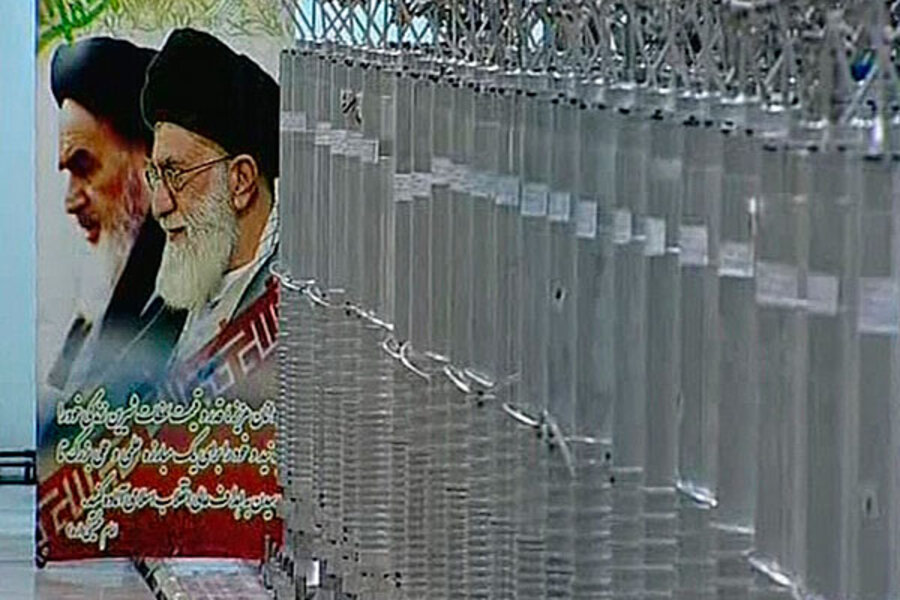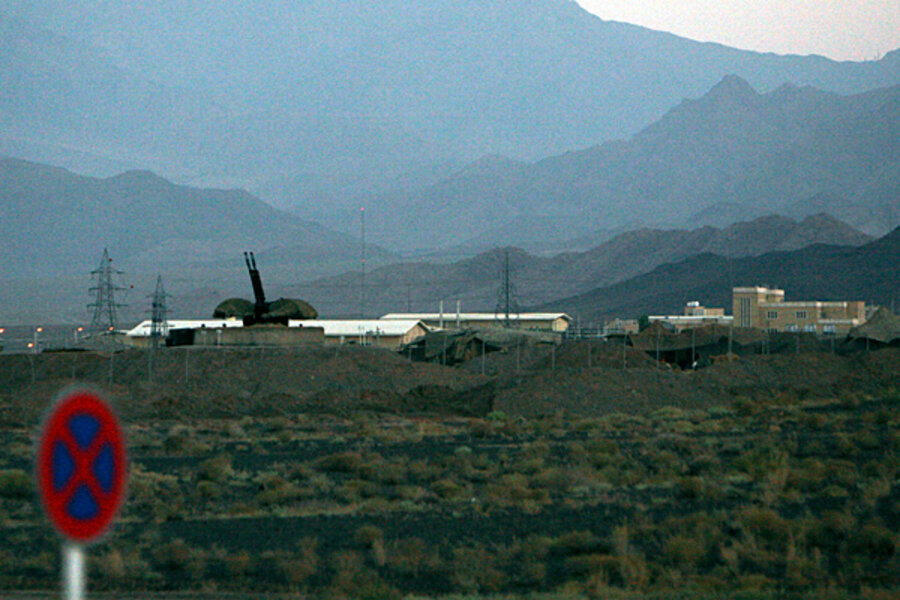Iran maneuvers for upper hand ahead of nuclear talks
Loading...
| Istanbul, Turkey
Iran is continuing to advance its nuclear program, according to a new report by United Nations inspectors, gaining bargaining chips on the eve of a new round of talks with six world powers in Kazakhstan.
After an eight-month hiatus, Iran will sit down on Feb. 26 with the five permanent members of the UN Security Council plus Germany (known as the P5+1) to find ways to cap Iran’s nuclear progress.
After three failed rounds of talks last spring, P5+1 diplomats now say they will make a “substantial and serious offer” to Iran in an effort to convince it to give up sensitive nuclear work that could lead to a bomb.
Yet expectations are low for a breakthrough in the Kazakh city of Almaty.
News reports indicate only slight changes to the last P5+1 offer Iran rejected, which required Iran to take key irreversible steps before any possibility of significant sanctions relief. Iran’s June presidential election also makes any deal unlikely now.
Toeing the 'red line'
The report yesterday by the UN International Atomic Energy Agency (IAEA) shows that Iran is moving forward deliberately, yet carefully: Making advances while nuclear talks have been stalled, but not so much progress that it triggers the military strikes threatened by Israel and the US.
The IAEA report details an expansion of Iran’s ability to enrich uranium – the process that produces nuclear fuel and at a higher level serves as the raw material for nuclear weapons – and the first-time installation of a new generation of centrifuge for more efficient enrichment.
Yet the IAEA also reports that Iran’s stockpile of 20 percent enriched uranium – the material that most concerns Israel and the West, because it is a few technical steps from bomb-grade – grew slower than expected.
That stockpile now stands at 167kg, below the 240kg declared by Israel as its “red line” because that amount – by Israel’s count, at least – is enough to make a single weapon if enriched further.
The stockpile grew slowly because Iran converted nearly two-thirds of its newly made 20 percent enriched uranium to a form for fuel use, rendering it unsuitable for use in weapons.
All of Iran’s declared nuclear facilities are under IAEA surveillance and frequent inspection. But the IAEA scolded Iran for lack of cooperation and failure to agree on a “structured” plan to clarify unresolved issues and for access to the military site at Parchin, which is not a declared nuclear facility but is suspected of being a site of implosion experiments a decade ago.
The IAEA stated that it is therefore “unable…to conclude that all nuclear material in Iran is in peaceful activities.”
A softening of stance?
In Kazakhstan, the P5+1 will reiterate demands that Iran stop all 20 percent enrichment, shut its deeply buried facility at Fordow, and ship out of the country all its 20-percent enriched uranium stockpile, as well as accept measures that will make it forever impossible for Iran to go for a bomb, if it chose to do so. Though being touted as a "serious" new and updated offer, "the next proposal is remarkably close to the old one," and is "a way to test whether they are serious or not," one P5+1 official told Reuters.
Iran says it rejects nuclear weapons as un-Islamic, but demands recognition of its right to peaceful nuclear technology – as a signatory of the Nuclear Non-Proliferation Treaty – and wants sanctions lifted that have helped cripple its economy.
“The mood is shifting…. We’ve heard about an ‘upgraded and credible offer,’” says Shashank Joshi, a research fellow at Britain’s Royal United Services Institute.
“When you talk to [P5+1 officials and diplomats], you clearly see the movement in the direction of, ‘We need to put some sanctions relief on the table, for a meaningful stop-shut-and-ship-style deal,’” says Mr. Joshi. “They’re not saying it, but they are saying, ‘We made a mistake,’ even though none of them will admit to that.”
Past incentives such as airplane parts for Iran’s aging fleet were “pathetic,” though they did technically qualify as “sanctions relief,” says Joshi, author of “The Permanent Crisis: Iran’s Nuclear Trajectory.”
“Are we on the same page [as the Iranians] to what ‘upgraded’ means, and to what ‘meaningful” means?” adds Joshi. “The challenge for the Europeans and the Americans is this: How do you craft a form of sanctions relief that is sufficient to elicit Iranian cooperation, without so easing the pressure on Iran that it sees no need to cooperate in other areas of dispute?”
Stated White House policy toward Iran has had two tracks: applying pressure while pursuing diplomacy.
According to Vali Nasr, a Pakistan and Iran expert who worked inside the Obama administration for two years, in reality the strategy on Iran was “not even dual. It relied on one track, and that was pressure,” he writes in a new book due out in April, as quoted by Roger Cohen in The New York Times this week.
“Engagement was a cover for a coercive campaign of sabotage, economic pressure and cyberwarfare,” writes Mr. Nasr. “Pressure has become an end in itself.”
Chances of a step-by-step process seemed to fade and Washington’s lack of interest would have been clear to Iran, because “the sum total of three major rounds of diplomatic negotiation was that America would give some bits and bobs of old aircraft in exchange for Iran’s nuclear program,” Nasr writes.
Technological problems
Senior Iranian officials have dismissed that carrot-and-stick approach as suitable only for donkeys. Iran’s Supreme Leader Ayatollah Ali Khamenei on Feb. 7 also nixed direct US-Iran talks for the time being, blaming sanctions – which the US Congress has tightened further in recent weeks – and clandestine actions against Iran.
“You [Americans] are pointing the gun at Iran and say either negotiate or we will shoot,” Khamenei said, adding that Iran “will not be frightened by the threats.”
The IAEA reported that in the past three months, Iran installed 2,255 more of its 1970s model IR-1 centrifuge, making the total 12,669 at its primary Natanz facility. Only about two-thirds are currently working.
The IAEA also said that Iran had started installation of 180 centrifuges of a new IR-2 model, which can enrich five times faster. Yet there has been no change in the past nine months of the number of centrifuges enriching to 20 percent at both Fordow and Natanz.
The manufacture of so many new centrifuges and the steady upward trend of Iran’s enrichment over the years indicate that sanctions, sabotage, and computer viruses have had little strategic impact on Iran’s nuclear progress.
But centrifuges continue to produce less today and throughout 2012 at Natanz, after peaking in 2010.
“This consistently lower enrichment output likely indicates that Iran is continuing to have trouble with the IR-1 centrifuges,” notes an analysis of the IAEA report by the Institute for Science and International Security in Washington.
US State Department spokeswoman Victoria Nuland called the IR-2 installation "yet another provocative step" by Iran, and a "further escalation." UN Security Council resolutions require that Iran halt all enrichment activities until it clears up remaining questions about alleged past weapons-related work.
One of Iran's goals in continuing to enrich to 20 percent could be "its usefulness as a bargaining chip," writes Yousaf Butt, a nuclear physicist at the Monterey Institute of International Studies, in the National Interest.
"What are perceived in the West as being provocative steps towards a nuclear weapons capability may just be negotiating strategy to get the draconian sanctions removed," Mr. Butt writes.
The P5+1 should put “serious sanctions relief on the table,” says Butt, though such a step is unlikely next week in Kazakhstan.
"There appears to be a striking cognitive dissonance between the pronouncements of the alleged mortal threat posed by Iran's nuclear program and the foot-dragging approach to doing something about it in negotiations," adds Butt.









